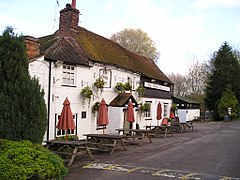Linslade
| Linslade | |
|---|---|
 The Globe Inn in Linslade |
|
| Linslade shown within Bedfordshire | |
| Population | 21,590 |
| OS grid reference | SP910259 |
| Civil parish | |
| Unitary authority | |
| Ceremonial county | |
| Region | |
| Country | England |
| Sovereign state | United Kingdom |
| Post town | LEIGHTON BUZZARD |
| Postcode district | LU7 |
| Dialling code | 01525 |
| Police | Bedfordshire |
| Fire | Bedfordshire and Luton |
| Ambulance | East of England |
| EU Parliament | East of England |
| UK Parliament | |
Linslade is an English town, located on the Bedfordshire side of the Bedfordshire-Buckinghamshire border (and roughly a third-way between London and Birmingham). It abuts onto the town of Leighton Buzzard with which it forms the civil parish of Leighton-Linslade(where the 2011 Census population was included). Linslade was transferred from Buckinghamshire in 1965, and was previously a separate urban district in its own right. It remained part of the Diocese of Oxford until 2008 when it joined Leighton Buzzard in the Diocese of St Albans. The original Anglo-Saxon settlement of Linslade, which was prominent during the 13th century, was not located at the modern site, but is to be found further north, and survives today as the hamlet of Old Linslade. The present location superseded the original during the 1840s, after massive growth associated with the construction of the Grand Union Canal and—particularly—the London and Birmingham Railway (now known as the West Coast Main Line). Linslade underwent a second major period of expansion, again associated with the railways, during the 1970s.
The name Linslade is Anglo Saxon in origin, and may mean "river crossing near a spring". (Though other plausible meanings exist.) The original form, recorded—for example—in the Anglo-Saxon Chronicle of 966, was Hlincgelad; then linchlade, pronounced lince-lade but by the time of the Domesday Book, in 1086, it had become Lincelada. The name continued to evolve, e.g. Lynchelade, in 1396, first appearing in its modern form in the 16th or 17th century, but with variations continuing into the 19th century.
...
Wikipedia

